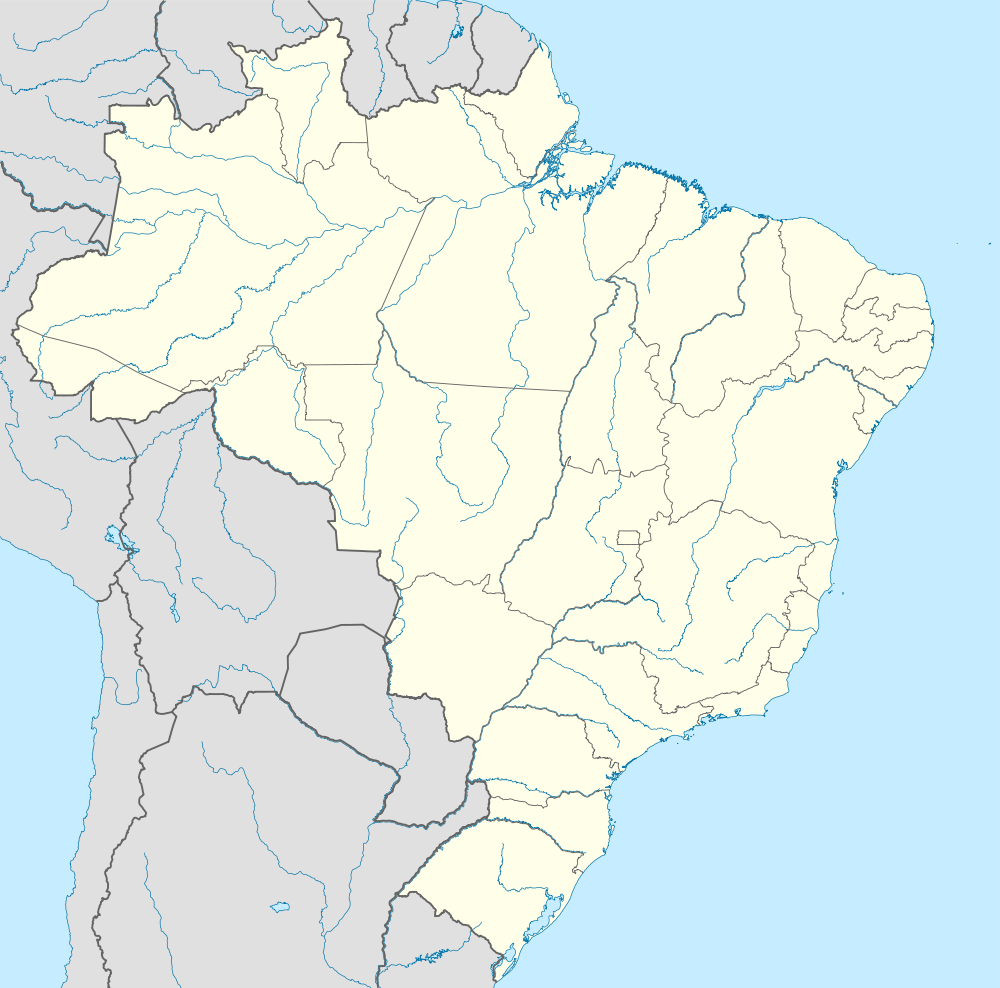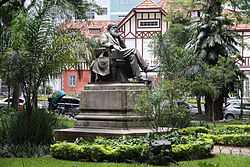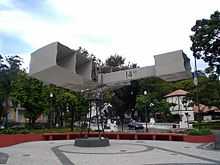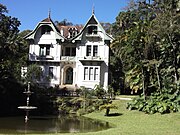Petrópolis
| Petrópolis | ||
|---|---|---|
| Municipality | ||
| Município de Petrópolis | ||
|
| ||
| ||
| Nickname(s): The Imperial City | ||
|
Motto: "Altiora Semper Petens" (Latin for "Always seeking higher things") | ||
 Location of Petrópolis in the state of Rio de Janeiro | ||
 Petrópolis Location of Petrópolis in Brazil | ||
| Coordinates: 22°30′18″S 43°10′44″W / 22.50500°S 43.17889°WCoordinates: 22°30′18″S 43°10′44″W / 22.50500°S 43.17889°W | ||
| Country |
| |
| Region | Southeast | |
| State |
| |
| Government | ||
| • Prefeito | Rubens Bomtempo (PSB) | |
| Area | ||
| • Total | 795.798 km2 (307.259 sq mi) | |
| Elevation | 838 m (2,749 ft) | |
| Population (2010) | ||
| • Total | 295,917 | |
| Time zone | UTC-3 (UTC-3) | |
| Website | www.petropolis.rj.gov.br | |
Petrópolis (Portuguese pronunciation: [ˌpeˈtɾɔːpʊʎiʃ]), also known as The Imperial City of Brazil, is a municipality in the state of Rio de Janeiro, at a distance of 68 km from the state capital.
Nestled among the forested hills of the Serra dos Órgãos, in the valley of the Quitandinha and Piabanha rivers, Petrópolis is a popular winter holiday spot. Besides the climate and surroundings, the main attraction is the former Summer Palace of the second Brazilian emperor, which is now the Imperial Museum, specializing in Imperial history and memorabilia.
Petrópolis is home to the National Laboratory for Scientific Computing, a research unit of the Ministry of Science and Technology of the Brazilian Federal Government.
History
The town's name ("city of Peter") honors Emperor Pedro II, the nation's second monarch and son of Pedro I.[1] The city was the summer residence of the Brazilian Emperors and aristocrats in the 19th century, and was the official capital of the state of Rio de Janeiro between 1894 and 1902.[1]
The town's origins can be traced to Bernardo Soares de Proença, who between 1722 and 1725 opened an alternative route between Rio de Janeiro and Minas Gerais, across the Serra da Estrela. While traveling to Minas Gerais along this route, Emperor Pedro I found the region's climate pleasant, while staying at the farm of Correia, a Catholic priest. As the priest's sister and heiress refused to sell his property, the Emperor bought in 1830 the neighboring one, the Córrego Seco Farm. He had his Summer Palace built there, but never saw it finished, because he stepped down from the throne, on April 7, 1831.[2] Other Brazilian aristocrats eventually followed suit. Pedro's Palace is nowadays the Imperial Museum, one of the main attractions of the "alpine city" of Petrópolis, together with the Cathedral of Saint Peter of Alcântara, the Crystal Palace and the House of Santos-Dumont. The "Imperial City"[1] became in due time home to artists, intellectuals and celebrities, and by the twentieth century, one of the main tourist attractions in the country.
German farmers from the Rhineland were encouraged to immigrate and to settle on the Emperor's outlying lands, to help give the Palace a charming urban setting. The settlement of Petrópolis was founded on March 16, 1843.[1] It became a city in 1857. The road connecting the city to Rio de Janeiro was opened in 1910 and paved in 1928. The urban design was carried out by Major-Engineer Julius Friedrich Koeler.
On a visit to the Philadelphia Exposition of 1876, Pedro II was impressed by Alexander Graham Bell's new invention, the telephone, and had a line connecting his Summer Palace to his farm headquarters.
Even after the establishment of the Republic and the exile of the Imperial family in 1889, the city continued to play a significant role in Brazilian history. It was a frequent choice as summer residence for presidents of the republic, who lodged at the Palace of Rio Negro. In 1903 the Rio Negro Palace saw the signing of the Treaty of Petrópolis with Bolivia, which gave Brazil the Acre territory.
During the dictatorship
There was a centre for torture, called the House of Death.[3]
Climate
Petrópolis has a subtropical highland variety of the Oceanic Climate (Köppen climate classification Cfb) caused by elevation with humid summers. The rainfall is approximately 2,400 mm (94 in) per annum.
The temperature is mild. The annual average is around 19 °C (66 °F). In warmer months, the average temperature is 23 °C (73 °F) and the average of the coldest month is 15 °C (59 °F). According to the National Institute of Meteorology (pt: Instituto Nacional de Meteorologia), the lowest temperature recorded was −0.7 °C (30.7 °F) on August 2, 1955 and the highest temperature recorded was 36.6 °C (97.9 °F), on November 6, 2009.
| Climate data for Petrópolis | |||||||||||||
|---|---|---|---|---|---|---|---|---|---|---|---|---|---|
| Month | Jan | Feb | Mar | Apr | May | Jun | Jul | Aug | Sep | Oct | Nov | Dec | Year |
| Average high °C (°F) | 26.8 (80.2) |
27.5 (81.5) |
27.1 (80.8) |
25.7 (78.3) |
22.7 (72.9) |
22.3 (72.1) |
21.5 (70.7) |
23.2 (73.8) |
23.3 (73.9) |
25.1 (77.2) |
25.1 (77.2) |
26.1 (79) |
24.7 (76.47) |
| Average low °C (°F) | 17.5 (63.5) |
17.5 (63.5) |
17.1 (62.8) |
15.7 (60.3) |
13.1 (55.6) |
11.9 (53.4) |
11.3 (52.3) |
12.1 (53.8) |
13.3 (55.9) |
15.0 (59) |
15.9 (60.6) |
17.0 (62.6) |
14.78 (58.61) |
| Average rainfall mm (inches) | 311 (12.24) |
156 (6.14) |
149 (5.87) |
64 (2.52) |
39 (1.54) |
17 (0.67) |
29 (1.14) |
24 (0.94) |
51 (2.01) |
104 (4.09) |
188 (7.4) |
251 (9.88) |
1,383 (54.44) |
| Avg. rainy days (≥ 0.1 mm) | 18 | 13 | 13 | 7 | 6 | 3 | 4 | 4 | 7 | 9 | 14 | 17 | 115 |
| Average relative humidity (%) | 83 | 84 | 85 | 86 | 87 | 84 | 83 | 82 | 80 | 81 | 82 | 86 | 83.6 |
| Source #1: INMET, 7 year average (INMET),[4]INMET[4] | |||||||||||||
| Source #2: Rio 2016 web site[5] | |||||||||||||
Tourism
The main attractions of the city are:
- Açu Hill (Serra dos Órgãos National Park)
- Casa Stefan Zweig
- Castle of the Baron of Itaipava
- Crystal Palace
- District of Itaipava
- Fatima’s Throne
- Grão-Pará Palace
- House of Ipiranga (“House of the Seven Mistakes")
- House of Joaquim Nabuco
- House of Princess Isabel
- House of Rui Barbosa
- House (chalet) of Santos-Dumont
- House of the Baron and Viscount of Arinos
- House of the Baron and Viscount of Mauá
- House of the Viscount of Caeté
- Imperial Museum of Brazil
- Monastery of the Virgin
- Petrópolis City Park
- Petrópolis Wax Museum
- Quitandinha Palace
- Rio Negro Palace
- Rural touristic tours of Taquaril, Brejal and Araras
- Saint Peter of Alcantara Cathedral (Cathedral of Petrópolis) with the Imperial Mausoleum
- Valparaíso (Gastronomic and Entertainment Center of Petrópolis)
- Bauernfest (Annual Festival in honor to the German immigrants)
Notable people
- Michel de Souza, operatic baritone, born in Petrópolis[6]
- Peter Brian Medawar, Winner of the Nobel Prize in Physiology or Medicine, among other awards.
- Rodrigo Santoro, Actor who has appeared in many successful movies, including 300, What to Expect When You're Expecting, among others
- Camila Morgado, Brazilian Actress
- Guilherme Fontes, Brazilian Actor
- Fiorella Mattheis, Brazilian Actress
- Pierre Baitelli, Brazilian Actor
- Stefan Zweig, Austrian author, lived in Petropolis from 1940 until his suicide in the same city in February 23, 1942.
- Magda Tagliaferro, Brazilian Pianist
- Dom Pedro de Alcântara, Prince of Grão-Pará
- Prince Luís of Orléans-Braganza
- Rafael da Silva, English club Manchester United footballer
Economy
Petrópolis' economy is based on tourism, services and industry. It is the 2nd largest beer production centre in the country and the headquarters of major Brazilian brewery companies such as Grupo Petrópolis (Which owns the beer brands Itaipava, Crystal, Lokal, Black Princess and Petra) and Bohemia, and also has a Brasil Kirin Factory. [7][8]
Gallery
-

Landscape of Petrópolis (Woodland with a Creek), unknown date.
-

Baron of Rio Branco's house
-

Landscape of Petrópolis, unknown date.
-
Imperial Palace of Petrópolis, circa 1855.
-

Araucaria angustifolia, Brazilian pine
-

The railway engine 11 was used on the railway line that, during the period 1883-1964, ran between Rio de Janeiro and Petrópolis.
-

Indaiá's brook
-

Quitandinha Lake
-
Quitandinha Palace in autumn
-
House of Ipiranga (“House of the Seven Mistakes")
-

Monument to Dom Pedro II in the garden of the square that bears his name.
-

Statue of Pedro II in the Imperial Museum
-
Landscape of Petrópolis, in front of the Imperial Museum
-

Palácio Amarelo (Yellow Palace), The City Council of Petrópolis
-
Crystal Palace
-

Bench in center of Petrópolis
-

Center
-

City entrance
-

Bus Station
-
Petropolis' Mountains
-

Catholic University of Petrópolis
-

Vale Imperial Residence
-

City centre
-

Rua do Imperador (Emperor Street)
-

Rua do Imperador (Emperor Street)
-
View from cathedral tower
-

14-bis Square
-

Irmãos D'Ângelo Street
-

Christian Church
-

Commercial street in Downtown Petropolis
-
Obelisk
-

Museum of Weapons
-

"The Enchanted", Santos-Dumont's Chalet
-
Petropolis view from Cathedral
-
Liberdade Square
-

Hydrangeas
-

Trail at the "Serra dos Órgãos" National Park
-

"Tribuna de Petrópolis" Journal
Sister cities
Petrópolis is sister city of:
References
- ↑ 1.0 1.1 1.2 1.3 "Emperor Street". World Digital Library. 1860–1870. Retrieved 2013-08-24.
- ↑ Home
- ↑ Torturerte politiske fanger i Brasil, nå er han funnet drept
- ↑ 4.0 4.1 "INMET - Rio de Janeiro". INMET. November 2013. Retrieved November 24, 2013.
- ↑ "Climatological Information for Petrópolis, Brazil". Rio 2016. Retrieved November 24, 2013.
- ↑ "Michel de Souza". www.roh.org.uk. Royal Opera House. Retrieved 26 February 2014.
- ↑
- ↑
External links
| Wikimedia Commons has media related to Petrópolis. |
- (Portuguese) Petrópolis City Hall
- (Portuguese) Tourist Information of Petropolis
- (Portuguese) Petrópolis, The Imperial City: Gallery
- (English) (Portuguese) Views of Petrópolis
- (English) (Portuguese) Bauernfest - The Festival of the German Settlers
| |||||||||||||||||||||||||||||||||||||||||||||||||||||||||||||||||||||||||||||||||||||||||||||

















